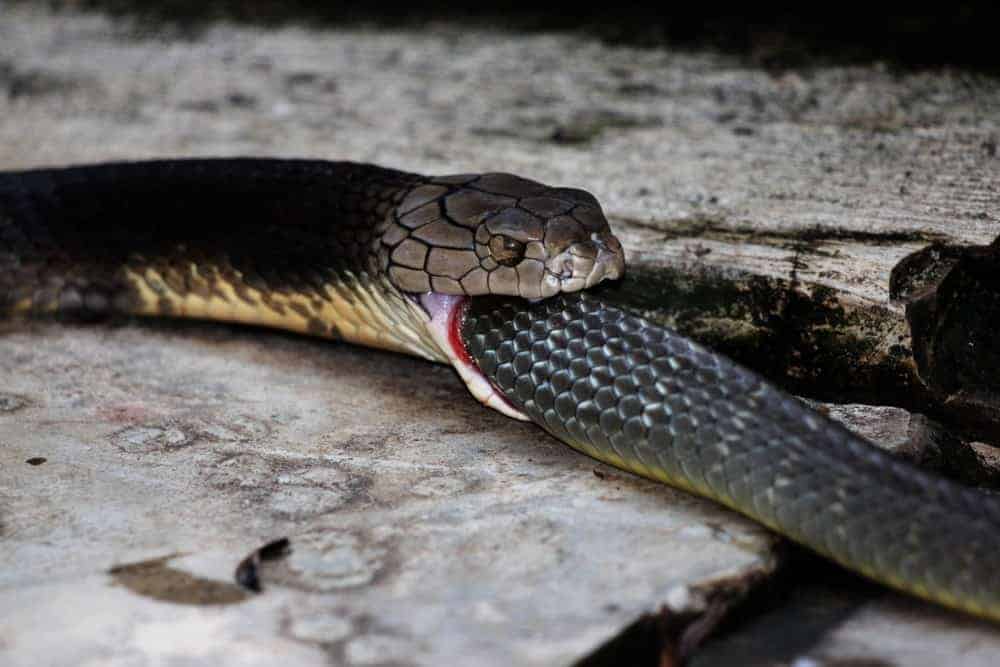What eats snakes are often portrayed as fearsome predators in the natural world. With their stealth, venom, and constriction techniques, they play crucial roles in balancing ecosystems by controlling populations of rodents, insects, amphibians, and even other snakes. But despite their prowess, snakes are not invincible. In fact, they are preyed upon by a surprisingly diverse array of animals—many of which are equally skilled hunters.
This article takes an in-depth look into the various animals that eat snakes. From birds of prey to mammals, reptiles, amphibians, and even humans, we explore how and why different species prey on snakes, the ecological significance of these interactions, and the strategies snakes use to evade becoming a meal.
Birds: Snakes’ Most Persistent Aerial Threats
Birds are arguably the most common and widespread predators of snakes. With their keen eyesight and the advantage of flight, birds can spot and snatch up snakes with deadly precision.
A. Raptors (Birds of Prey)
Birds of prey, such as hawks, eagles, kites, and owls, are some of the most formidable predators of snakes.
Secretary Birds
found in sub-Saharan Africa, are uniquely adapted to hunt snakes on the ground, delivering powerful kicks that can crush a snake’s skull or spine.
Eagles
like the Crested Serpent Eagle and Snake Eagle, are snake specialists in Asia and Africa, often targeting venomous snakes with skill and confidence.
B. Corvids and Other Opportunistic Birds
Crows, ravens, and herons have also been observed preying on snakes, especially smaller ones. While not specialized snake hunters, their intelligence and adaptability make them opportunistic feeders.
Mammals: Furry Foes of the Serpent World
Many mammals hunt and consume snakes, particularly those that are quick, agile, and resistant to venom.
A. Mongooses: The Iconic Snake Killers
Mongooses are perhaps the most famous snake predators in the mammalian world. Their claim to fame comes from their agility and partial resistance to snake venom. The Indian gray mongoose, for instance, is known for killing cobras. It uses rapid, darting movements to avoid strikes and attacks the snake’s head to incapacitate it quickly.
Wild Cats and Canines
Various wild cats (like the caracal and serval) and canids (jackals, coyotes, and foxes) will eat snakes when the opportunity presents itself. While these animals typically prefer mammals or birds, a slow-moving or injured snake can become an easy meal.
Raccoons and Opossums
These omnivorous animals are opportunists. In the U.S., raccoons have been known to consume snakes, especially when other food is scarce. Opossums are particularly interesting because they have a high resistance to snake venom, including from rattlesnakes.
Reptiles: When Snakes Eat Each Other
Reptiles, including other snakes, are common snake predators. In the wild, cannibalism and interspecies predation among snakes are more common than one might expect.
King Snakes and Kingsnakes
The term “king” in king snakes refers to their tendency to eat other snakes. Kingsnakes, found in North and Central America, are immune to rattlesnake venom and often prey on venomous species. They kill by constriction and are known for their efficiency and boldness.
Cobras and Large Pythons
Some large cobras and pythons also prey on other snakes. The King Cobra, the world’s longest venomous snake, feeds almost exclusively on other snakes, including smaller cobras, kraits, and rat snakes.
Monitor Lizards and Crocodilians
In some ecosystems, large lizards like monitor lizards and Nile monitors feed on snakes, especially eggs and juvenile individuals. Similarly, young snakes may fall prey to crocodiles and alligators, although this is more opportunistic than a primary food source.
Amphibians: Unexpected Predators
Though less common, some large amphibians are known to consume snakes, especially smaller or juvenile ones.
Bullfrogs and Toads
The American bullfrog, one of the largest frogs in North America, is a voracious eater. It has been documented eating garter snakes and other small serpents. Cane toads, due to their sheer size and insatiable appetite, can also consume hatchling snakes in areas where their ranges overlap.
Fish: Underwater Snake Hunters
Aquatic snakes, like water moccasins and sea snakes, face threats from underwater predators.
Large Fish Species
Fish such as bass, catfish, pike, and even sharks in marine environments may eat snakes. This is more common when snakes venture into water bodies or when young snakes are still developing and vulnerable.
Crocodiles and Alligators (Again)
These reptiles spend much of their lives in water and won’t hesitate to consume snakes that cross their path, especially when they’re small or injured.
Humans: Predators by Culture and Circumstance
Humans are among the most impactful predators of snakes, whether for food, fear, fashion, or medicine.
Culinary Delicacy
In various cultures, snake meat is considered a delicacy. In parts of China, Vietnam, Thailand, and the southern United States, snakes—especially rattlesnakes and pythons—are hunted for their meat. It is believed to be nutritious, rich in protein, and even aphrodisiacal in some traditions.
Traditional Medicine
In Traditional Chinese Medicine (TCM), snake parts are used in various remedies. Snake wine (a whole snake soaked in alcohol) is believed to improve virility and treat ailments such as rheumatism.
Fear and Safety
Many humans kill snakes out of fear, especially in rural areas where venomous species are prevalent. Unfortunately, this sometimes includes harmless and even beneficial snakes.
Invertebrates: Small But Deadly Predators
While it’s rare, some invertebrates have developed techniques to kill and consume snakes.
Spiders and Scorpions
Certain species of tarantulas and scorpions have been documented killing juvenile snakes. These encounters are rare but remarkable, often occurring when snakes invade the spiders’ burrows or territories.
Large Ant Colonies
In tropical regions, army ants or fire ants can overwhelm small or injured snakes, especially during coordinated raids. Their sheer numbers and venomous bites make them formidable enemies for any small animal.
Snake Defense Mechanisms
Given all these threats, it’s no surprise that snakes have evolved an arsenal of defense strategies.
Camouflage
Snakes come in a dazzling variety of colors and patterns, many of which are designed to help them blend into their environment. This helps them avoid detection by both prey and predators.
Venom and Constriction
Many snakes use venom as both a hunting and defensive tool. A well-placed bite from a venomous snake can deter a would-be predator. Non-venomous snakes often rely on constriction and swift strikes to intimidate or escape.
Mimicry
Some harmless snakes mimic the coloration of venomous ones—a phenomenon called Batesian mimicry. For instance, the scarlet kingsnake mimics the coral snake’s red, black, and yellow bands to discourage predators.
Escape Tactics
Some snakes exhibit dramatic escape behaviors. The hognose snake, for example, plays dead—flipping onto its back and sticking out its tongue—to appear unappetizing. Others, like the spitting cobra, can shoot venom from a distance to irritate a predator’s eyes.
Ecological Role and Balance
Snake predation is not just about survival—it’s a key component of ecosystem health. The fact that snakes are both predator and prey keeps food webs in balance.
Removing snakes or their predators from ecosystems can lead to imbalances. For instance, overhunting of birds of prey may lead to an explosion of rodent populations, as fewer snakes are kept in check by those birds.
Conclusion
Despite their fearsome reputation, snakes are a vital and vulnerable part of the food chain. They are hunted by a diverse group of predators—from agile birds and venom-resistant mammals to fellow reptiles and even humans. Understanding who eats snakes helps us appreciate their place in the intricate web of life and underscores the need for balanced conservation efforts.
As much as snakes rely on stealth, venom, and speed to survive, the natural world is teeming with creatures that have evolved just as impressively to make a meal out of them. In this constant dance between hunter and hunted, snakes are not just survivors—they are essential players in the world’s ecosystems.












+ There are no comments
Add yours